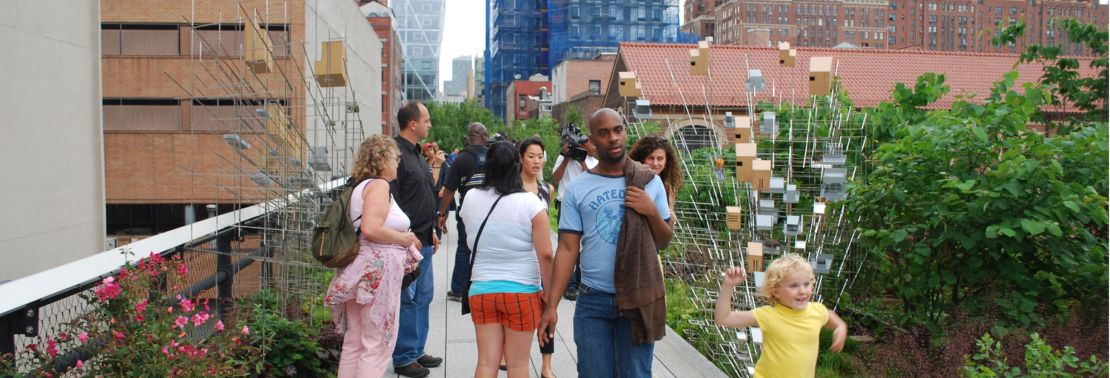A Comparison of the Three Phases of the High Line, New York City: A Landscape Architect and Photographer’s Perspective
“A Comparison of the Three Phases of the High Line, New York City: A Landscape Architect and Photographer’s Perspective” compares Phase One with Phase Two, and describes what is proposed for Phase Three. Design features to be reviewed include the walk system, seat furnishings, plantings, signage and graphics, water feature and drinking fountains, public art, lighting, maintenance and irrigation, and Phase 3. The author also offers suggestions on economic impacts, restrictions and user activities, sustainability, and studies/research.
Originally, due to the length and photo essay nature of the contribution, the series was presented approximately every few weeks in 14 parts between 2013 and 2015; to ensure background information, the Series Introduction is repeated on all.
Part 6 – Public Art
By Steven L. Cantor, Landscape Architect – Originally Posted March 12, 2014
All Photos © Steven L. Cantor
Series Introduction
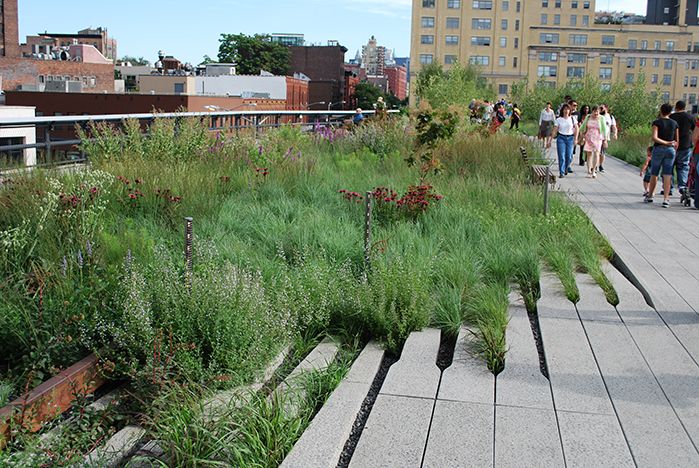
Phase One High Line on July 15, 2009.
Designed by landscape architect James Corner of Field Operations, architect Ricardo Scofidio of Diller Scofidio + Renfro with planting design by Piet Oudolf, the High Line, the remarkable linear park built on an abandoned railroad viaduct in New York City, has been enormously popular.
The design team anticipated how well green roof technology would function and adapt to the viaduct since it could handle at once the huge weight of several fully-loaded trains carrying heavy tonnage. As an intensive green roof, it has very few structural load limits which would curtail use. At peak use times there can be lines of pedestrians waiting to enter with as many as 20,000 visitors per day on weekends.[1]
The High Line has won numerous awards, and in particular several as a green roof, for example, in 2013 and 2010 from the American Society of Landscape Architects, Green Roofs for Healthy Cities in 2011, and in 2010 from the International Green Roof Association. This is a rare public project in which the success of the initial phase contributed to a high level of funding for subsequent phases.
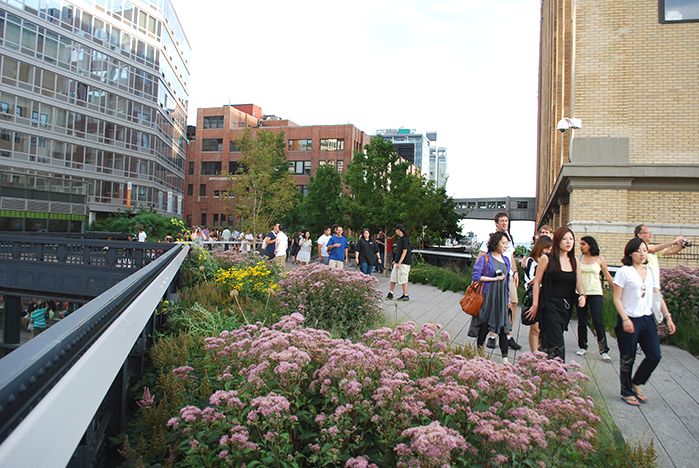
7.16.11.
The High Line has benefited from intense scrutiny as a result of lectures in which the designers were questioned; public hearings, media critiques in newspapers, journals, and blogs; lobbying from specific organizations, such as the Rainforest Coalition; and comments from city government and other public officials.
Improvements or adjustments were implemented to some design elements of the first phase, and significant modifications were done in the second phase. Are these changes aesthetic, appropriate and ethical, and are they consistent with the goals of sustainability? Is the High Line a sustainable design?
Part 6: Public Art Discussion
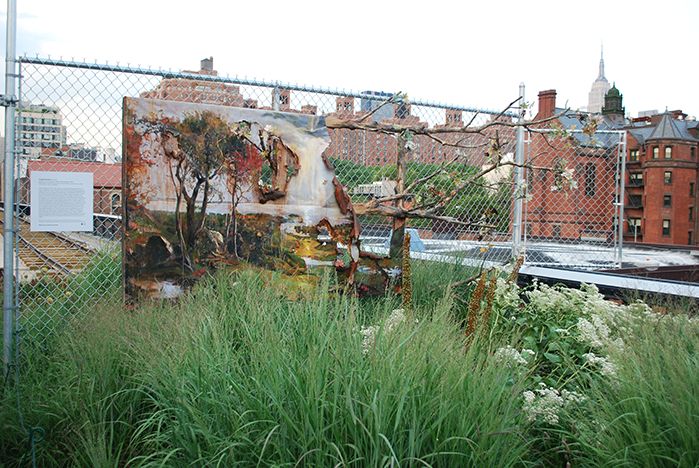
Valerie Hegarty’s Autumn on the Hudson Valley with Branches; 6.25.10.
From the initial opening of the first phase, the High Line has incorporated public art. Some installations were temporary, such as a fanciful sculpture decorating the construction fence separating the completed first phase from the second phase work under construction.
In some ways the High Line’s emphasis on art has matched the development of the West Chelsea neighborhood, which now is home to hundreds of art galleries and artists’ studios. It’s not uncommon to have a new exhibit open in a gallery that has a corollary installation in the High Line.
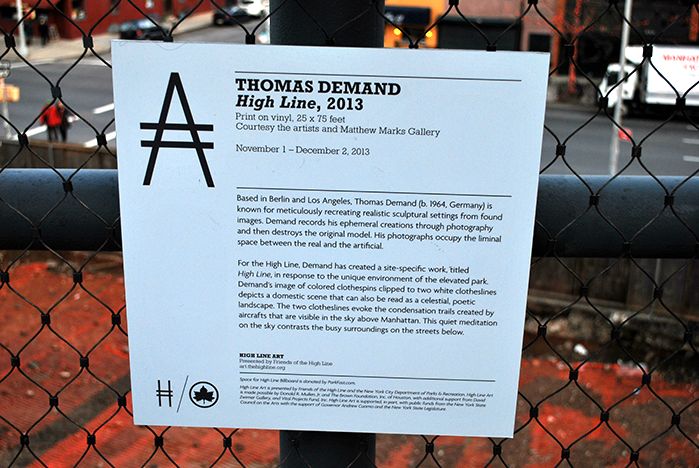
High Line Billboard on West 18th Street and 10th Avenue by Thomas Demand; 10.14.13.
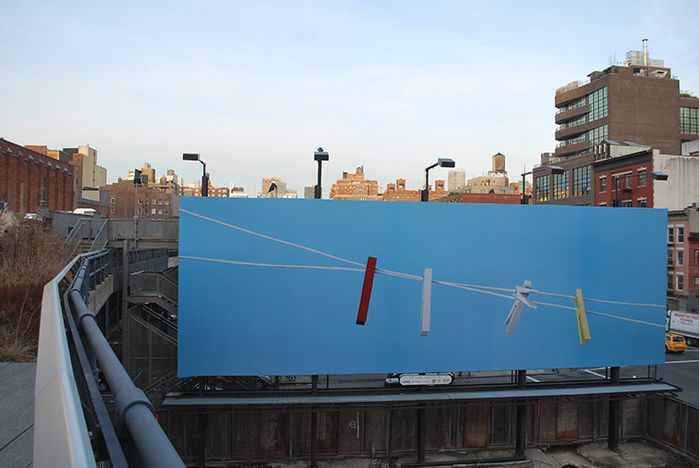
11.30.13.
Near the Tenth Avenue Square a perforated metal screen was set up and people were encouraged to look through its openings for controlled views of the Chelsea cityscape.
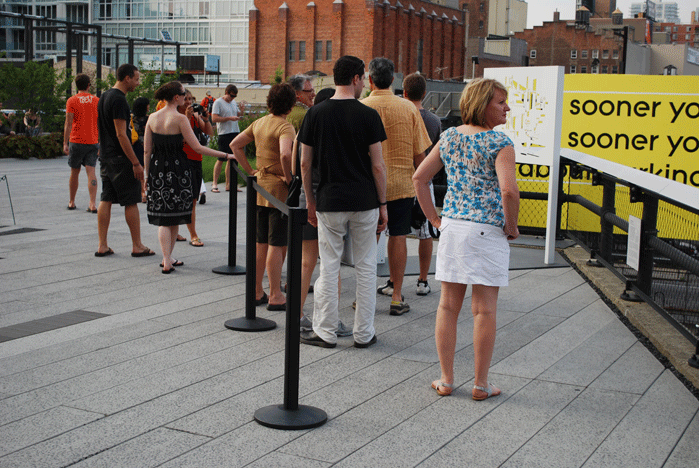
People are lined up waiting to look through the screen; 6.25.10.
The second phase of the High Line incorporated more elaborate installations, which are left in place for a certain number of months and then replaced with something new. Sarah Sze’s “Still Life with Landscape – Model for a Habitat,” was a stainless steel sculpture that included boxes for birds’ nests set on either side of the walk.
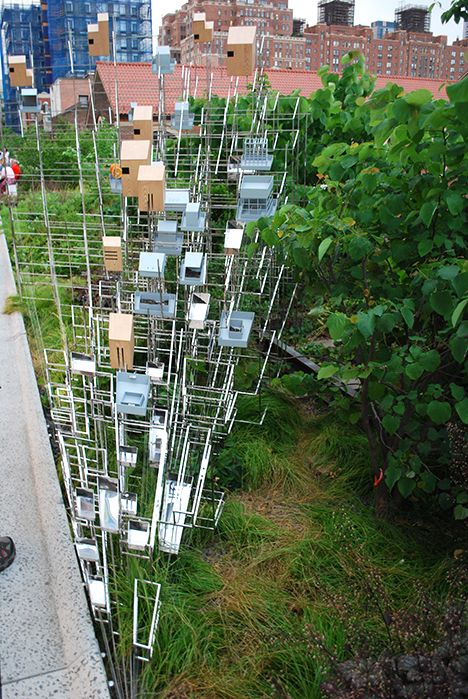
Sarah Sze’s Still Life with Landscape – Model for a Habitat; 6.10.11.
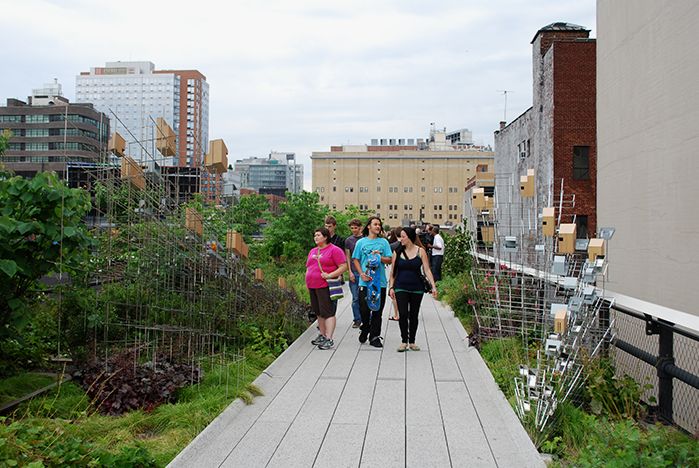
6.16.11.
Julianne Swartz’s “Digital Empathy” was set within the public water fountains, elevators, and restrooms. Normally inanimate objects greet visitors with spoken messages of empathy and love. It is a novel experience to hear soothing — if innocuous and banal — recorded messages while using a drinking fountain, elevator or restroom.
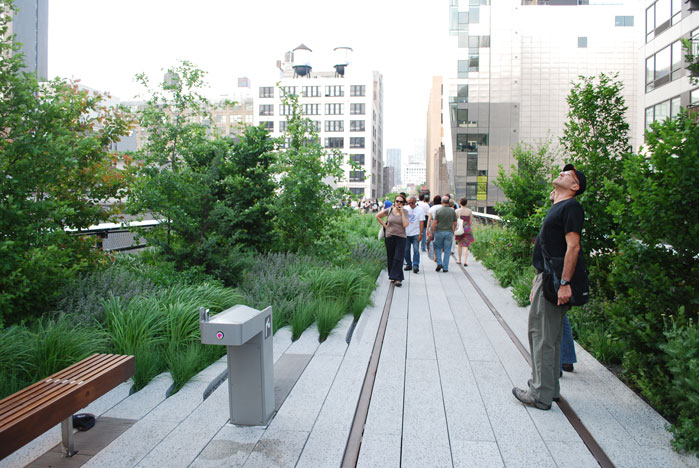
Where is that sound coming from? 6.10.11.
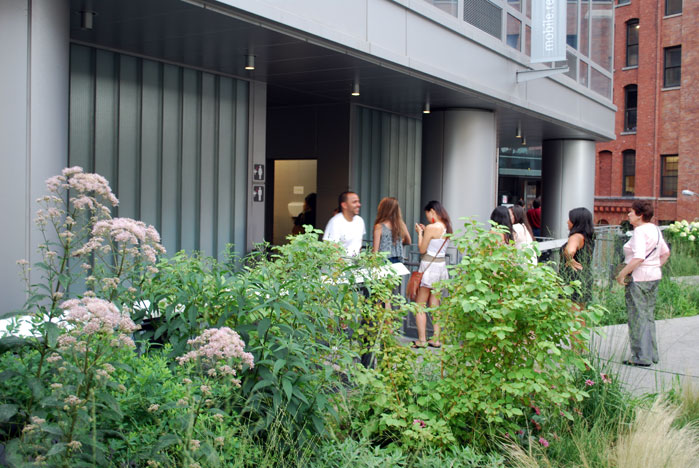
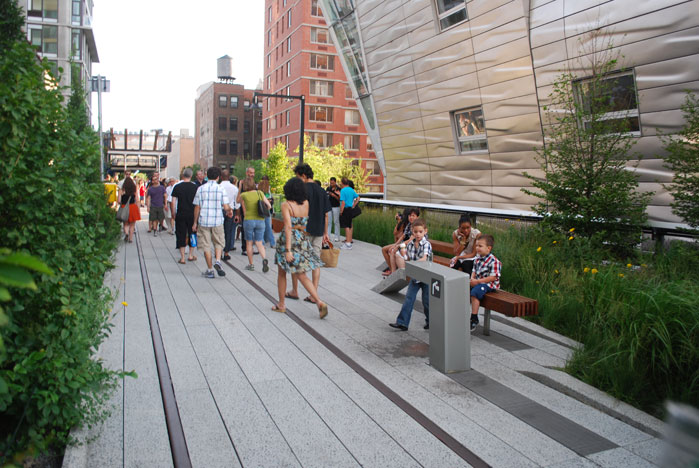
Listening to Julianne Swartz’s Digital Empathy; 7.16.11.
Another public art technique is The High Line Channel, ongoing video installations, using as projection screens the walls of adjacent buildings at two different locations.
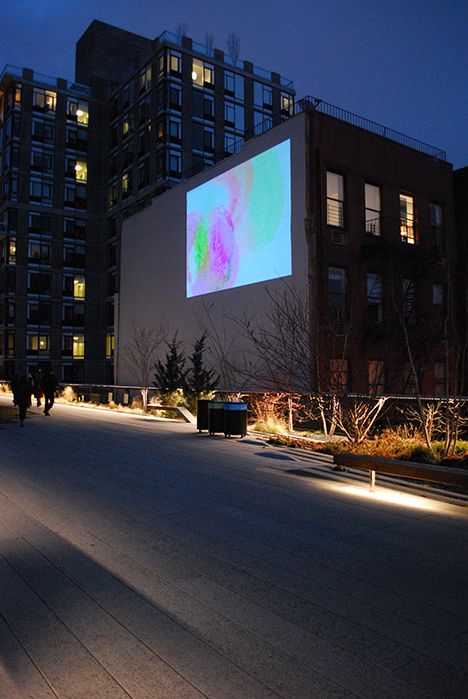
High Line Channel 14; 2.18.12.
A current project is a series of sculptures called “BUSTED,” by nine international artists: Frank Benson, Steven Claydon, George Condo, Mark Grotjahn, Sean Landers, Goshka Macuga, Ruby Neri, Amalia Pica, and Andra Ursuta.
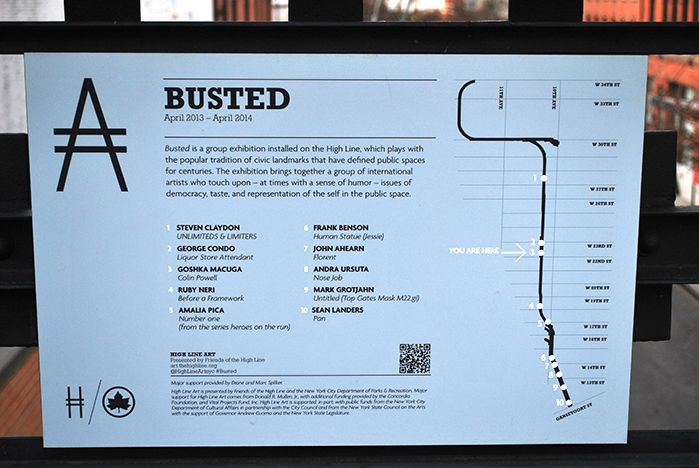
11.30.13.
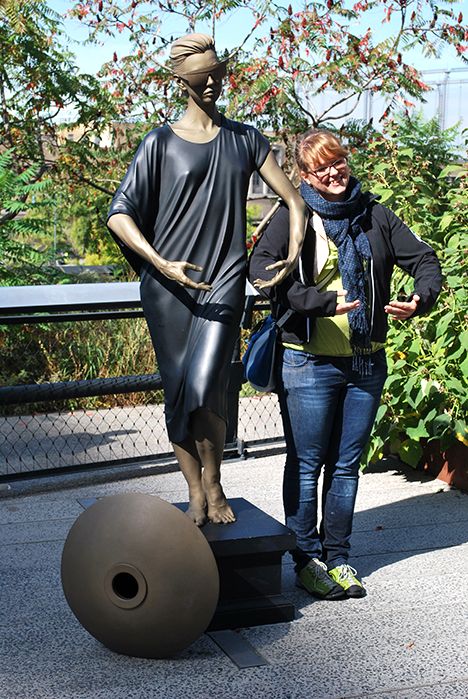
Human Statue (Jessie) by Frank Benson; 10.14.13.
The sculptures are placed at varied locations, both in paved areas and planting beds, throughout the entire two phases of the High Line. These abstract busts are created to celebrate and commemorate important historical figures as well as the tradition of honorific statues over many centuries.
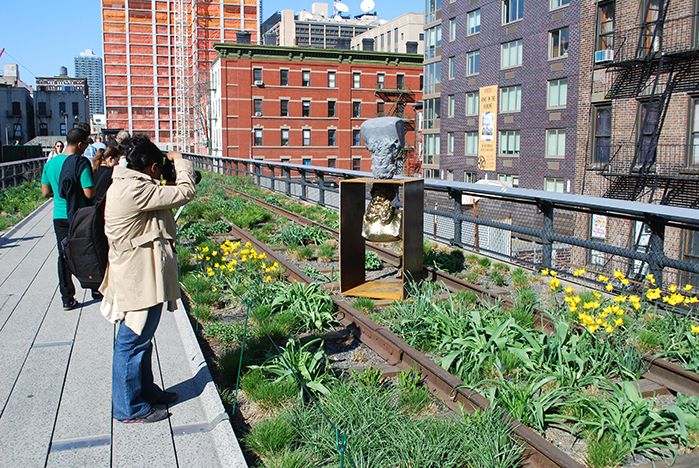
Steven Claydon’s UNLIMITEDS & LIMITERS; 4.27.13.
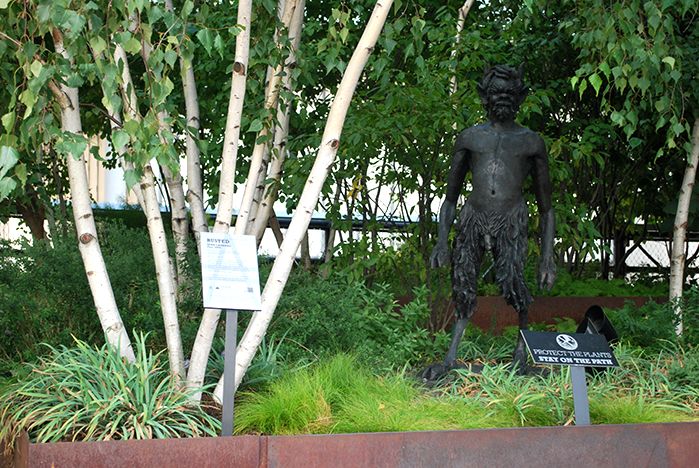
Sean Landers’ Pan; 10.14.13.
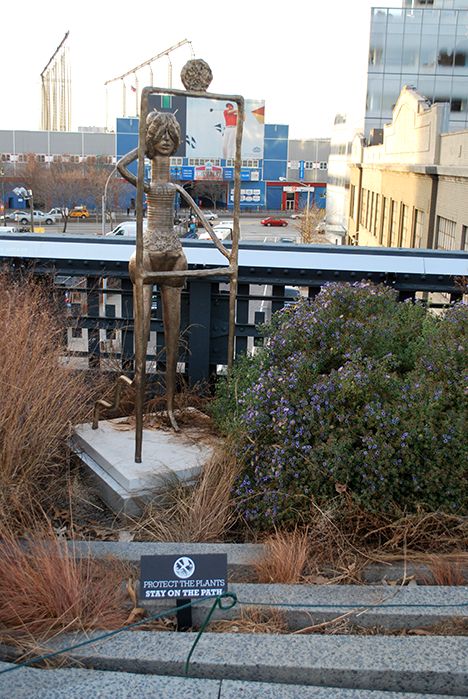
Ruby Neri’s Before a Framework; 11.30.13.
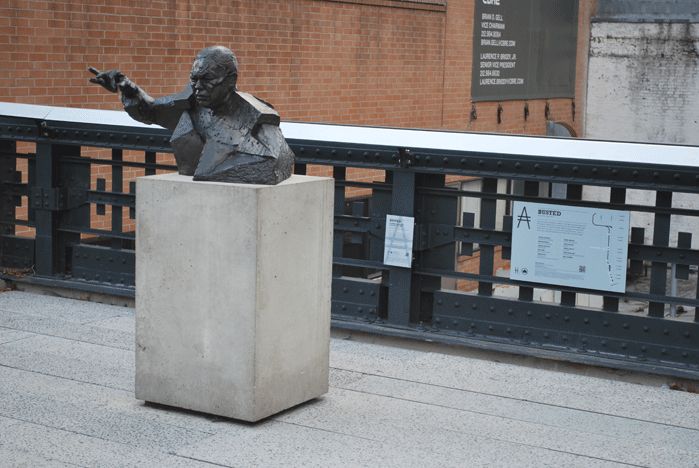
The sculpture is of Colin Powell by Goshika Macuga in the “BUSTED” Series.
Chosen by popular vote, a tenth and final BUSTED sculpture was determined in 2013. Participants selected a person to be commemorated in a sculpture on the High Line. The winner of the BUSTED competition was Florent Morellet, and the sculpture of him, below, was incorporated into the High Line. Florent Morellet is an artist and activist famous for his Restaurant Florent in the Meatpacking district immediately adjacent to the High Line, which finally closed after being a community center for over twenty years.
Commissioned by Friends of the High Line, John Ahearn is the artist/sculpture who executed the Florent Morellet plaster cast mounted on the wall of a building along the High Line. All of the BUSTED sculptures will be on view through April 2014.
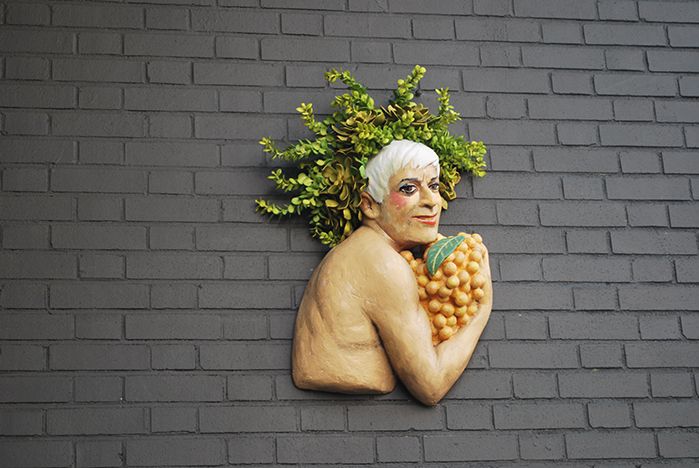
The life-size plaster cast of Florent Morellet by John Ahearn; 12.01.13.
At the intersection of 10th Avenue and W. 24th Street, a Getty gas station that was sold for $25 million will be the site of a luxury condominium with 12 to 15 apartments in an 11 to 12 story building, the maximum height permitted adjacent to the High Line. As a nice decorative touch while awaiting development amidst a neighborhood full of art galleries, the site is the home for a temporary sculpture installation called “Sheep Station” by Francois-Xavier Lalanne, who has transformed the space to create a fenced, “undulating green pasture with a herd of epoxy, stone and bronze sheep.”
The Economic Impacts of the High Line is the subject of a future discussion.
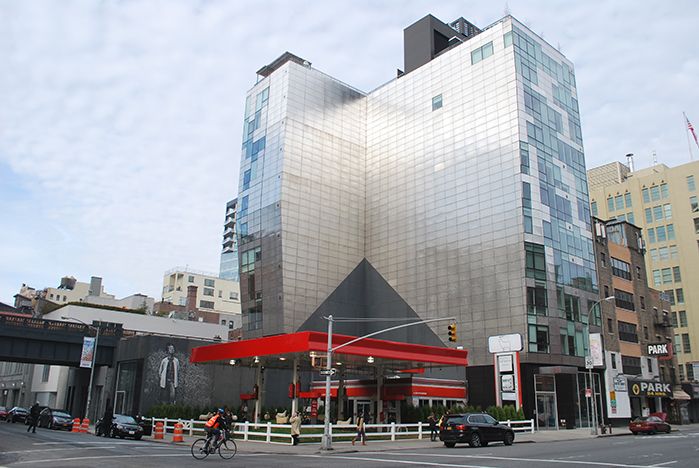
The Getty Gas Station at the NW corner of 10th Avenue and West 24th Street, New York City; 12.01.13.
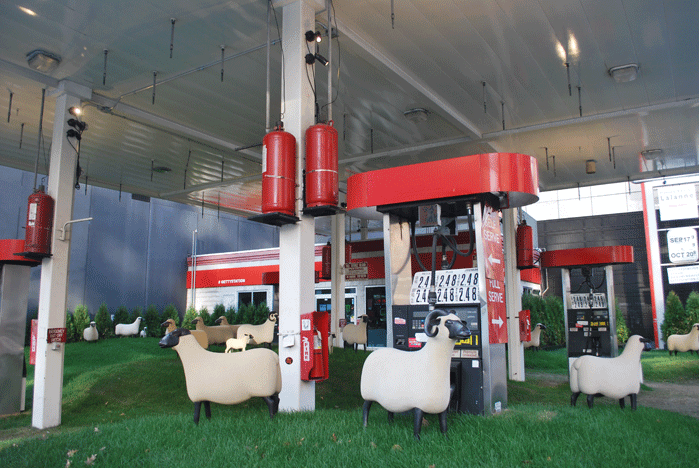
Sheep Station: a herd of sheep on rolling grass meadow by Francois-Xavier Lalanne with public art on the wall; 10.13.13.
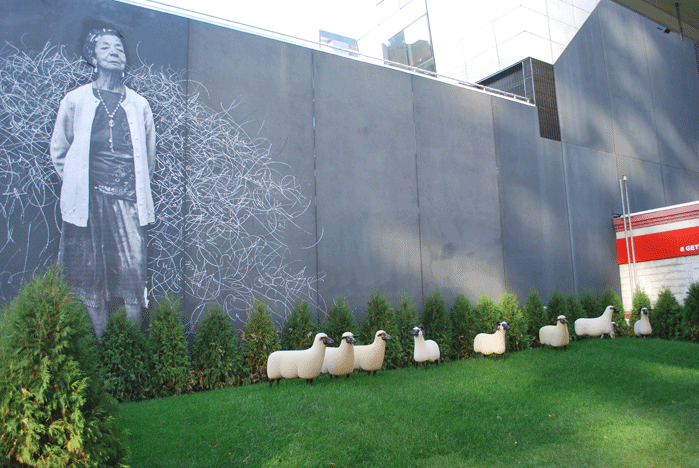
A permanent art installation is “The River That Flows Both Ways,” by Spencer Finch, built into overarching architectural walls of buildings bridging the High Line between West 15th and 16th Streets. The installation is a grid of glass squares, each of which represents a hue from photographs of the Hudson River during the artist’s trip on the water.
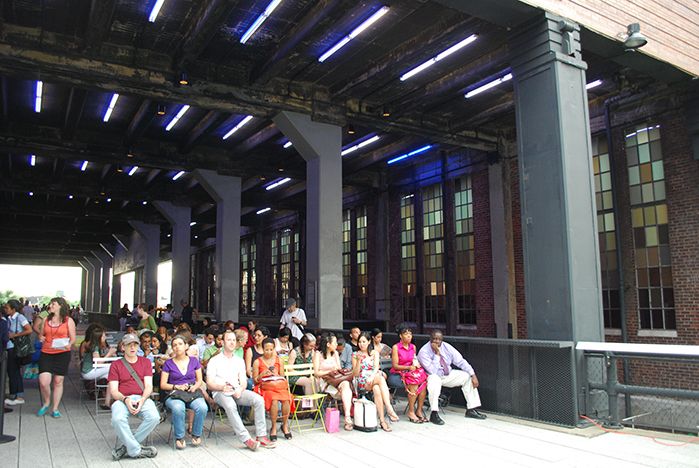
The people above are seated to the side of the glass panels of The River That Flows Both Ways art work, waiting for a lecture; 6.16.11. Below is a view of the Hudson River from the space; 9.25.09.
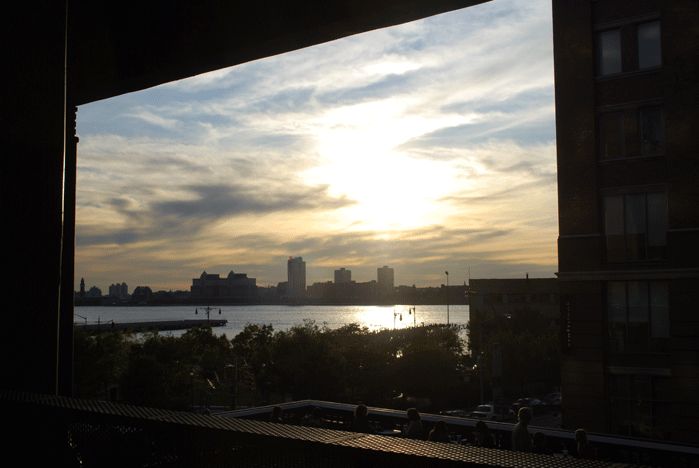
Additional High Line Public Art Photos
That’s it for now. I hope that these different sections of text and images of the High Line will generate discussion.
Come back next time for Part 7 of “A Comparison of the Three Phases of the High Line, New York City: A Landscape Architect and Photographer’s Perspective” where I’ll discuss Lighting.
Steven L. Cantor
Photos © Steven L. Cantor are available for individual purchase.
Cumulative 14-part “A Comparison of the Three Phases of the High Line, New York City: A Landscape Architect and Photographer’s Perspective” Series End-notes
1. Ulam, Alex. “Back on Track,” Landscape Architecture Magazine. Volume 99, No. 10, October, 2009, p. 97.
2. http://www.thehighline.org/news/2012/01/24/major-milestone-for-the-high-line-at-the-rail-yards
3. http://www.thehighline.org/sustainability
4. http://www.thehighline.org/design/planting
Publisher’s Note:
See Steven L. Cantor’s ENTIRE 14-part “A Comparison of the Three Phases of the High Line, New York City: A Landscape Architect and Photographer’s Perspective” Series.
Steven L. Cantor, Landscape Architect
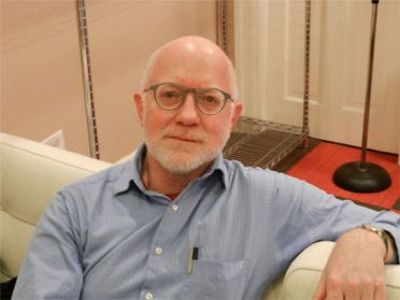
Photo by Thomas Riis.
Steven L. Cantor is a registered Landscape Architect in New York and Georgia with a Master’s degree in Landscape Architecture from the University of Massachusetts, Amherst. He first became interested in landscape architecture while earning a BA at Columbia College (NYC) as a music major. He was a professor at the School of Environmental Design, University of Georgia, Athens, teaching a range of courses in design and construction in both the undergraduate and graduate programs. During a period when he earned a Master’s Degree in Piano in accompanying, he was also a visiting professor at the College of Environmental Design at the University of Colorado, Boulder. He has also taught periodically at the New York Botanical Garden (Bronx) and was a visiting professor at Anhalt University, Bernberg, Germany.
He has worked for over three decades in private practice with firms in Atlanta, GA and New York City, NY, on a diverse range of private development and public works projects throughout the eastern United States: parks, streetscapes, historic preservation applications, residential estates, public housing, industrial parks, environmental impact assessment, parkways, cemeteries, roof gardens, institutions, playgrounds, and many others.
Steven has written widely about landscape architecture practice, including two books that survey projects: Innovative Design Solutions in Landscape Architecture and Contemporary Trends in Landscape Architecture (Van Nostrand Reinhold, John Wiley & Sons, 1997). His book Green Roofs in Sustainable Landscape Design (WW Norton, 2008), provides definitions of the types of green roofs and sustainable design, studies European models, and focuses on detailed case studies of diverse green roof projects throughout North America. In 2010 the green roofs book was one of thirty-five nominees for the 11th annual literature award by the international membership of The Council on Botanical & Horticultural Libraries for its “outstanding contribution to the literature of horticulture or botany.”
Steven’s most recent book is Professional and Practical Considerations for Landscape Design (Oxford University Press, 2020) where he explains the field of landscape architecture, outlining with authority how to turn drawings of designs into creative, purposeful, and striking landscapes and landforms in today’s world.
He has been a regular attendee and contributor at various ASLA, green roofs and other conferences in landscape architecture topics.
In recent years Steven has had more time for music activities, as a solo pianist and accompanist. In 2011 he performed a solo piano program at the Winter Rhythms festival at Urban Stages Theater. He’s a regular performer at musicales hosted in Chelsea and other settings in Manhattan. On August 25, 2013, Leonard Bernstein’s birthday, he performed with Stephen Kennedy Murphy a program of excerpts from the composer’s MASS and Anniversaries.
Steven joined the Greenroofs.com editorial team in December, 2013 as the Landscape Editor. In February, 2015 he completed his 14-part series “A Comparison of the Three Phases of the High Line, New York City: A Landscape Architect and Photographer’s Perspective.”
 Greenroofs.comConnecting the Planet + Living Architecture
Greenroofs.comConnecting the Planet + Living Architecture
